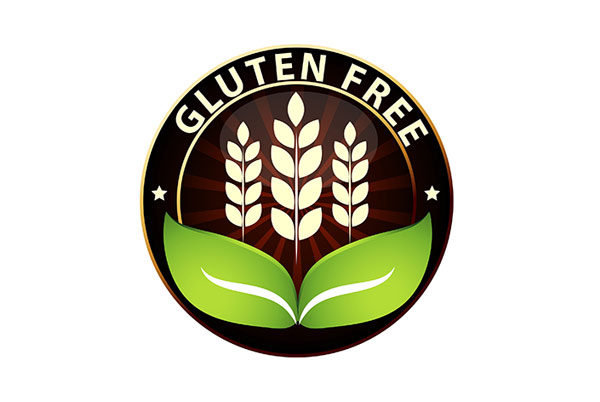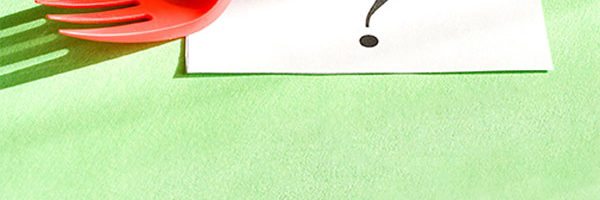
Demystifying Labels
We put a call out to our Facebook readers for input on the most confusing aspect of gluten-free living. Overwhelmingly, readers wanted to know how to read labels for gluten and discern what is safe. We’ve got you covered!
We’ll run through the rules and challenges in several categories of foods: packaged foods which contain gluten as an ingredient, foods that have been “glutened” by cross-contamination, and other items that are not covered by our current laws in the US.
Packaged Foods
What’s covered in this category:
• Pretty much anything in a box on the shelf at the grocery store
What’s not covered:
• Meat, poultry, and eggs
• Anything served at a restaurant, bakery, or prepared foods department
• Medications and over-the-counter drugs
• Items not intended for human consumption (such as cosmetics and pet food)
There are only a few main words that indicate gluten is an ingredient. Remember, we’ll be talking about cross-contamination a little later!
• Wheat
• Rye
• Barley (malt, malt flavoring, malt vinegar, Brewer’s yeast, and rarely smoke flavoring)
• Oats that are not labeled gluten-free
Wheat
Fortunately for us, wheat is covered under the 2006 Food Allergen Labeling Protection Act, which requires manufacturers to label common allergens in plain English. Under the law, this can be done in one of two ways. The law specifies that one or the other must appear, but not necessarily both.
• The label needs to have wheat clearly spelled out within the text of the label. Example: Flour (wheat)
OR
• There must be a statement at the bottom of the label. Example: Contains WHEAT
As I’m guessing you’ve seen, there are oh-so-many names for wheat:
• Bulgar
• Couscous
• Durum
• Einkorn
• Emmer
• Farina
• Farro
• Flour (cake flour, pastry flour, self-rising flour, whole wheat flour, enriched flour, etc.)
• Freekah
• Kamut
• Matzo
• Semolina
• Spelt
• Tabbouleh
• Triticale
So if a packaged product contains couscous, it would need to say: Couscous (wheat) OR Contains wheat.
The nice thing here is that when ingredients are derived from wheat, it can’t be hidden under another term, at least not under packaged foods regulated by the FDA law.
Many ingredients can, in theory, contain wheat, such as:
• Dextrin
• Food starch
• Maltodextrin
• Monosodium glutamate (or MSG)
• Modified food starch
• Natural flavorings
However, these ingredients rarely contain gluten. Corn is super cheap in the US due to government subsidies, so companies almost always use corn over wheat.
In the unlikely event that one of the above ingredients did contain gluten, the label would legally have to say: Food starch (wheat) OR Contains wheat.
So unless you see wheat on the label, all of those weird chemical words you’re seeing on labels are not derived from wheat. (That doesn’t mean that they’re good for you or supportive of your overall health.)
Barley
Barley is a bit trickier. Because it isn’t technically one of the top eight allergens, it doesn’t need to be explicitly named the way wheat does. Barley will be listed as one of the following:
• Malt (flavoring, extract)
• Brewer’s yeast (rarely)
• Smoke flavoring (rarely)
Smoke flavor and Brewer’s yeast can legally contain barley, although this is quite rare. In the 10 years I’ve been gluten-free, I’ve never seen a product containing Brewer’s yeast or smoke flavor which didn’t list barley on a label.
The following are generally considered safe:
• Natural flavor
• Caramel color
As we mentioned in the section on wheat, if a product with natural flavor contains wheat, it will be spelled out. Legally, natural flavors can contain barley, which doesn’t need to be listed on a label. Since barley malt is an expensive ingredient, it’s rarely lumped under the natural flavoring term. In the past few years, the major celiac centers and books have moved natural flavoring from the “caution” column to the “safe” column.
Caramel coloring can legally be sourced from barley, however, the manufacturers in the US and Canada do not use barley, so this is also considered gluten-free.
So where does barley show up? Well, label reading is always a must. Barley can show up in quite a few sneaky places:
• Broth
• Brown rice syrup
• Chocolate
• Flavored vinegars
• Miso
• Soups
• Teas
There are many kinds of chocolate, soups, teas, and more made without barley, but these are products that you want to look at extra closely. Go to the product’s website or call the manufacturer if you have any doubts.
Rye
Rye is generally only present in rye bread and some alcohols. It’s an uncommon ingredient. I’ve never heard of “hidden” or unlabeled rye in a packaged product.
Oats
First, a little background. Oats technically don’t contain the same gluten protein as wheat, barley, and rye. However, oats are grown on the same fields and are often processed with the same equipment as wheat, so almost all regular oat products contain some wheat residue. Additionally, a small number of people with celiac disease or gluten sensitivity have the same reaction to pure oats as they do with gluten. While oats don’t legally need to be clearly labeled, generally they are. One exception is cut dates, which are often dusted with oats to keep them from sticking together. These may be found in trail mixes.
To summarize:
• Wheat is clearly listed on a packaged label when it is an ingredient.
• Barley shows up as malt, malt flavoring, malt vinegar, and/or Brewer’s yeast.
• Rye and oats are generally not “hidden” or unlabeled on packaged products.
Cross-Contamination
Cross-contamination happens when gluten is not intentionally added to a product as an ingredient, but is unintentionally added during processing, packaging, or serving.
A few examples of potential sources of cross-contamination during production include:
• The same equipment is used to harvest wheat and a gluten-free grain.
• A factory may use wheat flour on the same equipment as a naturally gluten-free flour.
• A bakery may bake both wheat-based and gluten-free items in the same space on the same day.
• A manufacturer may produce chocolate chips with barley malt and then chips without barley without cleaning the lines.
There’s a lot of gray area with cross-contamination, because labeling information about cross-contamination is currently voluntary. If you see a statement that reads, “Made in a factory with wheat,” sometimes it’s just a precaution and not a real problem. If you don’t see a statement, that doesn’t mean the product hasn’t been exposed or contaminated with gluten. It’s extremely confusing and frustrating for anyone who needs to be strictly gluten-free.
So what should you do?
- Choose products labeled “gluten-free,” especially flour and grain products. As of August 2014, products labeled gluten-free will contain under 20 parts per million, which is safe for most people with celiac disease.
- When possible, buy certified gluten-free products. Grains are the most likely to contain harmful levels of cross-contamination.
Certified gluten-free products are specifically tested and manufactured to exclude the risk of cross-contamination.
- Consider joining Gluten-Free Watchdog, a subscription service that tests products for the presence of gluten.
(Visit www.glutenfreewatchdog.org.)
- Always ask questions about how baked goods are prepared. Skip anything made in a shared facility.
Foods Not Under the FDA Law
We’ve looked at where gluten shows up in most packaged foods and also at cross-contamination. We also need to watch out for sneaky gluten in products that have different labeling laws, or no laws at all.
Meat, Poultry & Eggs
These foods fall under the Food Safety and Inspection Service (FSIS), which is under the USDA, not the FDA. While approximately 90% of labels for meat, poultry, and eggs do voluntarily label wheat clearly, it’s always a good idea to call manufacturers and double check ingredients in these products to be safe.
Unpackaged Foods
Approach anything served at a restaurant, bakery, or prepared foods department with caution. Do not feel bad about asking tons of questions! While naturally gluten-free foods are often a terrific option, always make sure to avoid any sources of possible cross-contamination. Avoid bulk bin foods. Foods like nuts and dried fruit, which are naturally gluten-free, pose a very high risk for cross-contamination. The August 2014 gluten-free labeling laws have stated that they will cover restaurant foods labeled gluten-free, but details have not been released as of the publication of this article.
Medications & Over-the-Counter Drugs
Medications are the Wild Wild West for gluten labeling. There are no laws regulating medications or for disclosing common allergens like wheat. There is no way to tell if a medication contains gluten by just reading the ingredient list. Gluten can be a filler, binder, or excipient in medications. Even a tiny amount is enough to cause problems in some individuals. Do speak to your doctor and pharmacist to ensure the safety of your medications. (Another great resource is www.glutenfreedrugs.com.)
Double check all over-the-counter drugs, too. Some varieties of Advil and even some digestive enzymes contain gluten.
Non-Food Items
Cosmetics, lotions, and other body care products do not have labeling laws for gluten. Because the majority of people are not bothered by gluten in these items (as the gluten molecule is too big to pass through the skin), most major celiac centers say that it’s not a problem. However, people with skin irritations or topical reactions to gluten should always choose brands labeled gluten-free.
Written by Cheryl Harris
Gluten Free & More magazine, by Edgewater Park Media Inc. (EPM) is publishing this article for purposes of medical topic, however no warranty is made that the article is accurate and there is no assurance that any statement contained or cited in the article touching on medical matters is correct, or up to date. EPM also states that nobody in EPM takes responsibility for the results of any attempt to use any information in the article. Always seek the advice of a medical professional before starting any new protocol.




Pingback: Label Reading 101 | onedishcuisine
Pingback: Gluten Free Almond Bars Recipe | Simply Gluten Free
Pingback: Gluten Free Brie Quesadillas with Mango Salsa and Chipotle Sour Cream Recipe | Simply Gluten Free